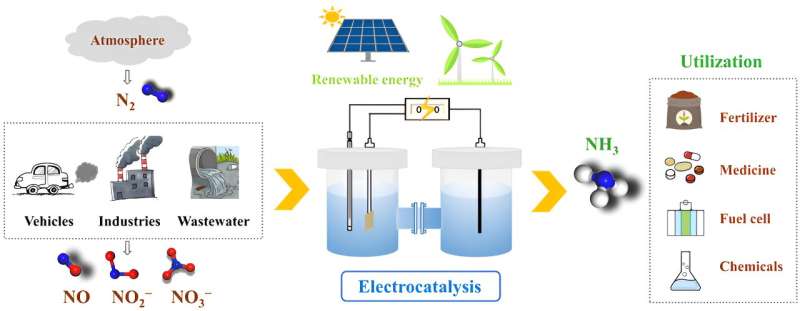by Chinese Academy of Sciences

NH3 is the second largest chemical produced in the world and nearly 80% of produced NH3 is employed in fertilizer synthesis. Meanwhile, NH3 is an indispensable raw material for manufacturing nitric acid, which can be further employed in chemical production.
Moreover, NH3 possesses high hydrogen capacity, making it a potential carbon-free fuel. As one of the greatest inventions, the Haber-Bosch process enables the large-scale production of value-added NH3; however, it is against the principle of sustainable development theory due to the high operational costs and negative environmental impacts of the Haber-Bosch process.
Hence, it is imperative to explore green and sustainable approaches to produce NH3 and simultaneously realize global environmental sustainability.
Artificial electrocatalytic NH3 synthesis (which can couple with clean renewable electricity) is recently becoming a research hotspot, where the majority of researchers use N2 gas as the N source. Although electrocatalytic N2 reduction reaction (NRR) provides an eco-friendly and sustainable route for ambient NH3 production, the conversion efficiency of N2 reduction to NH3 is unsatisfactory because of the high thermodynamic stability of the N2 molecule.
Fortunately, the more active N sources (i.e., NO, NO2−, NO3−) have been deemed as attractive precursors to achieve effective NH3 production, and meanwhile, the development of electrocatalytic NO reduction reaction (NORR) and NO3−/NO2− (NOx−) reduction reaction (NtrRR) is also expected to control and mitigate the related environmental pollution.
Although many promising studies have been done in the field of artificial electrosynthesis of NH3, the design and development of active electrocatalysts with high selectivity and stability to achieve efficient NH3 production remain certain challenges.
Recently, a research team led by Prof. Xuping Sun from University of Electronic Science and Technology of China introduced three electrochemical NH3 synthesis routes (NRR, NORR, and NtrRR) then summarized recent advances in electrocatalyst development for ambient NH3 synthesis, mainly involving catalytic mechanisms, theoretical advances, and electrochemical performance.
The challenges and future perspectives are also proposed in the concluding remarks, aiming to provide experience and inspire more critical insights for the electrocatalytic NH3 synthesis reactions. The results were published in the Chinese Journal of Catalysis.
More information: Ling Ouyang et al, Recent advances in electrocatalytic ammonia synthesis, Chinese Journal of Catalysis (2023). DOI: 10.1016/S1872-2067(23)64464-X
Provided by Chinese Academy of Sciences

